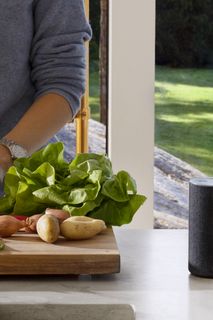His studio’s recent accolades include a gold medal and BBC People’s Choice Award for the Yeo Valley Organic Garden at the first ever September RHS Chelsea Flower Show in 2021 and ‘Best Small Residential Garden’ at the 2022 Society of Garden Designers awards.
Released in April 2023 is Tom’s first book, Published by Dorling Kindersly and written in close collaboration with the Royal Horticultural Society science team, ‘RHS Resilient Garden' is a future focused book grounded in the latest RHS research. It details how to work with nature and adapt your outdoor space to give it the best chance to flourish, using design principles, methods and techniques to support wildlife and promote biodiversity.
Web: https://tommassey.co.uk
Instagram: @tommasseyuk
PhotoCredit: Wax London
How to create a flourishing biodiversity zone in your garden

Simply leaving an area of your existing lawn to grow long will be beneficial to wildlife and have a positive effect on biodiversity, as the long grass will provide habitat and shelter, and flowering species will be able to bloom as they are not being constantly cut back. However, there are ways to speed up the process and further boost biodiversity in your rewilding zone. That is why we have partnered with Tom Massey, an award-winning designer and garden expert with a heart for biodiversity, to boost your rewilding zone and bring nature back into your garden. Here are his best ten tips on how to give an immediate boost to biodiversity.
- Cut as infrequently as possible - ideally as little as once or twice per year. This can be done in summer and again in the autumn.
- One way to encourage biodiversity is to remove all clippings after cutting. Removing clippings will reduce fertility of the soil and encourage flowering species and hinder grasses from dominating.
- If you have planted bulbs, don't cut the grass for 6 weeks after bulbs have finished flowering, they need the leaves to photosynthesize and store energy to flower again next year. Wait until leaves are yellow and flaccid, no longer able to produce food for the bulb.
- In autumn, while trimming the meadow, you can enhance its flora in the coming season by adding more plug plants or bulbs. This allows you to experiment with new species to increase biodiversity.
A wildflower meadow can be achieved quickly with the use of a meadow turf product. Meadow turf is a pre-grown species rich meadow mix that comes in rolls like standard lawn turf. It is laid like lawn turf but contains many more species of plants including many flowering species for pollinators. There are also numerous seed mixes on the market, but meadow turf is a more guaranteed way to successfully establish a meadow as it will suppress weeds and has been grown to a level of maturity in advance. Simply remove the area of your lawn you want to convert and lay the meadow turf in place, following the supplier’s installation guidelines. Look for a product with plenty of different species for added biodiversity.
Adding a more diverse range of plant species to your garden helps create a biodiverse haven. Pollinators and other invertebrates benefit from having a wide range of native and non-native plants. Non-native plants should also be considered as they can be more resilient to the effects of climate change (eg, drought) and extend the flowering period of a native-only planting scheme. Aim for at least five different species of flowering plants.
For a quick boost to biodiversity, add wildflower plug plants to your rewilding zone. Plug plants are small-sized plants that can be purchased inexpensively and added to the zone. Getting them to grow is simpler than with seeds and yields quicker results. To install the plugs, first, mow the area of the lawn and remove the grass cuttings. Then plant the plugs in randomized layouts for a natural effect. Aim for 5-10 plants per square metre.
Bulbs are typically planted in autumn (for spring flowering) and spring (for summer and autumn flowering). They’re an inexpensive way to enhance diversity. There are very early spring flowering bulbs, such as snowdrops (Galanthus species), that emerge when the landscape is looking bare. Try to plant bulbs that bloom one after the other, with new flowers showing up as the old one’s fade.
A good idea is to look for bulbs suited to the conditions in your garden. To get you started, here are some seasonal species suited to most European climates.
Winter / early spring:
Galanthus species (such as Galanthus nivalis & Galanthus elwesii)
Eranthis hyemalis
Iris unguicularis
Narcissus ‘February Gold'
Spring / early summer:
Allium ‘Purple Sensation’
Camassia quamash
Nectaroscordum siculum
Narcissus poeticus
Summer / autumn:
Allium cerulean
Allium sphaerocephalon
Cyclamen hederifolium Crocus (such as Crocus banaticus & Crocus pulchellus)
To make your rewilding zone even more interesting and useful, you can introduce purposeful design - for example, leave ‘islands’ of grass around trees, or create pathways through long grass to open areas. Get creative, resize and reshape, and perhaps even try out complex features like a labyrinth for a bit of fun.
Yellow Rattle (Rhinanthus minor) is semi-parasitic on grass species meaning its roots attach to grass roots and draw nutrients from them. Most grasses species are very vigorous and dominant and often outcompete wildflowers. Yellow rattle can help weaken grass dominance allowing other species to establish. It can help to open up an area of long grass for other plants to establish whilst also looking attractive and adding biodiversity too. The seeds need to be sown in autumn and will germinate the following spring. Approximately 0.5 grams per square metre is needed for a successful establishment.
Chemical pesticides and fertilisers can be extremely detrimental to biodiversity, as they don’t only target the intended pests and plants. In fact, to encourage wildflowers and reduce the dominance of grass, infertile soil is preferable, so you won't need to feed or fertilise your rewilding zone. If you do need to fertilise your garden, consider using homemade compost, or organic feeds such as seaweed based fertilisers rather than artificial chemical based products.
Inviting wildlife into your garden has many benefits. By leaving areas of shelter, eg, long grass, artfully stacked logs or a small pond, you can encourage predators like toads in. With the added benefit of these predators keeping potentially unwelcome visitors such as aphids, slugs, and snails at bay by eating them.
Maintaining a lawn can require a lot of water, particularly in the summer months. Consider harvesting rainwater to reduce pressure on main supplies and also reduce the cost of your water bill. This can be as simple as diverting down pipes into water butts, or you can go further by installing a full rainwater harvesting tank system.

Biodiversity is all about diversity
A garden rich in diversity of plant life will also attract a variety of insects and other wildlife - helping your garden thrive in a natural way.
If you want to dig even deeper, you can read more about our work with wildlife and biodiversity, as we have several ongoing projects aimed at improving our green spaces. For example, here is how you can create a bee friendly garden, or a hedgehog friendly garden. We also have an initiative called BioLife, where we’re shaping nature for life with biodiversity.

Tom Massey - Award-winning designer and garden expert with a heart for biodiversity
Tom Massey is a landscape and garden designer based in London, where he designs award winning gardens for private and commercial clients, as well as for festivals and shows in the UK and overseas. Tom strives to work with nature to produce sustainable, ecological and beautifully designed gardens that support local wildlife and promote biodiversity. Based in London, he works across the UK and internationally, always excited when work takes him somewhere new.







